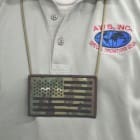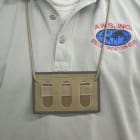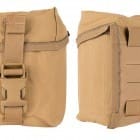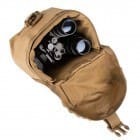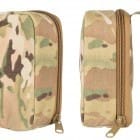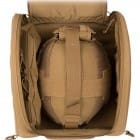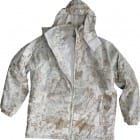A lot of info has been swirling around the internet over the past week regarding the US Army’s unending quest to find a new camouflage pattern. As crazy as some of it might sound, none of it is exactly wrong. But nothing you’ve read so far tells the complete story. I’ve written at length about the history of the Army’s Camouflage Improvement Effort that began five years ago after members of Congress asked the Army about the combat effectiveness of the Universal Camouflage Pattern adopted in 2004. Here is a Reader’s Digest version of the chain of events. Initially, the Army adopted the commercial MultiCam Pattern from Crye Precision for use in Afghanistan in 2010. This led to the Phase IV effort that investigated around 20 commercial families of camouflage patterns with different colorways for Transitional, Woodland, Arid and an optional fourth version for use with Organizational Clothing and Individual Equipment. These candidates were investigated against a baseline consisting of legacy camouflage patterns such as Marine Patterns (MARPAT) and the Navy AOR patterns. After an initial picture-in-picture trial to cull the herd to the most promising options, four companies were awarded contracts to provide printed fabric for field trials; ADS inc with Guy Cramer, Brookwood, Crye Precision and Kryptek.
After several delays in announcing the results of this multi-year effort, the Army abruptly stopped talking about Phase IV and quietly began discussing expanding the use of OCP for the entire Army, even going so far as to change the military name from Operation Enduring Freedom Camouflage Pattern to a more generic Operational Camouflage Pattern. However, negotiations with Crye Precision apparently didn’t work out as the Army had expected and their soft launch plan was put on hold.
I’ve blasted the Army in the past for not taking action regarding their quest for camouflage. Now, they’ve taken action. Unfortunately, it sounds like a broken record. There are reports that the Army will announce something in April but I believe if they even bother it will be an announcement of their new strategy that includes a new round of testing that begins next week. Results of this new testing won’t be available until the end of the fiscal year, if then.
PEO Soldier has been briefing the following Courses of Action:
1. Continue to negotiate with Crye Precision for a full license to use the MultiCam pattern as the Operational Camouflage Pattern. This license would also allow the Army to adapt MultiCam to create bookend patterns for Woodland and Arid environments. So far, this isn’t going well.
2. Adopt the Scorpion camouflage pattern along with bookend patterns for Woodland and Arid environments. Scorpion is a predecessor of MultiCam, developed for the Objective Force Warrior program. Occasionally, the Army’s Natick Labs, in charge of development of Soldier Systems gear, pulls Scorpion out and does some work on it. Although it differs slightly from MultiCam, over the years it has been tested against MultiCam and bookend variants have been developed. Considering Scorpion is even older than MultiCam, this would probably pass the NDAA sniff test as a legacy pattern.
3. Test and adopt a Digital Transitional Pattern with legacy bookend patterns from the MARPAT or AOR families. This is the one you’ve been hearing about in the news. Testing will be limited to NATO or picture-in-picture testing where Soldiers are shown a digital photo of a pattern inserted electronically into a photo of a natural environment and the Soldier is measured to see how long it takes to detect the pattern. Considering that all of the Phase IV finalists outperformed both AOR and MARPAT in picture-in-picture testing, it sounds like the Army is swinging for the fence of mediocrity. Additionally, the newly created DTP, whether created from Crye’s MultiCam or the Army’s Scorpion, will be a new pattern. According to federal law, all four services must adopt it for the Army to have its way.
2014 NDAA – The Elephant In The Room
Last year, Congress enacted a provision in the National Defense Authorization Act that was intended to streamline the development of all of these service specific patterns. Had the Army stuck with its original schedule, the NDAA wouldn’t have been an issue. But they didn’t. Now, they have to deal with the consequences of their inaction.
This is what the law says about new camouflage patterns.
(b) PROHIBITION.—Except as provided in subsection
(c), after the date of the enactment of this Act, the Secretary of a military department may not adopt any new camouflage pattern design or uniform fabric for any combat or camouflage utility uniform or family of uniforms for use by an Armed Force, unless—
(1) the new design or fabric is a combat or camouflage utility uniform or family of uniforms that will be adopted by all Armed Forces; (emphasis added)
Call me skeptical, but I’m not sure the Army is going to talk all of the services into adopting this new shake and bake pixelated transitional pattern (DTP). Otherwise, they violate the NDAA.
Echos of UCP?
“It’s déjà vu all over again”.
-Yogi Berra
I can only think of the great Yogi Berra’s quote when I consider what the Army is up to. Just 10 years ago it adopted the so-called Universal Camouflage Pattern just as it had concluded an extensive camouflage study. Ignoring all of the work that had been done, UCP came seemingly out of nowhere, combining features from different patterns, it became more of a fashion decision than an operational one. Sound familiar? Now, right on the heels of the most extensive camouflage study in history, the Army throws out all of the data and creates its own pattern based on other patterns that performed well in testing.
This time it’s worse for two fundamental reason. First, they should know better as they were raked over the coals just last year over the adoption of UCP and the “$5 Billion SNAFU”. Seems like SNAFU was more appropriate than I had originally thought. Second, such an action by the Army has the effect of Big Government hurting a small business.
Sure, they’re testing it. But it’s the computer based, NATO testing, and not full field trials like Phase IV.
The Licensing Fee
The point of the US Army Camouflage Improvement Effort was to do exactly what the name of the project says. From the outset, PEO Soldier said that the Army would allow the science to guide the process. Somehow that notion went out the window sometime over the past two years and money has become the central issue.
According to Army sources, and printed by both Military.com and Army Times, Crye Precision is seeking $24.8 Million from the Army to license the MultiCam pattern. As I understand it, this is an incorrect number, but that doesn’t really matter. What matters is that the Army has the audacity to quibble over $24 Million. The amount of money spent by the Army on camouflage is staggering. What’s worse, all the while that they continue to tap dance, the Army continues to purchase clothing and equipment in both the UCP and OCP camouflage. Years ago, the Army admitted that UCP was ineffective yet they continue to spend money on it. Who wants to bet that they won’t spend in excess of $24 Million between now and September on UCP?
Considering the new round of testing is going to cost even more money after they just completed testing of commercial patterns that cost in excess of $20 Million, it’s now bordering on the criminal. One interesting point. When the Army talks about what a project like this costs they only consider travel and procurement costs. Since their employees are paid no matter what they do, they don’t include those wage costs in the total like a commercial company would. This means that they grossly under report costs.
The next thing you are going to hear from these guys is how they are trying to be good stewards of the tax payers money. They spent well in excess of $5 Billion on UCP (some estimate that across DoD, almost $10 Billion was spent on UCP since 2004). Since adopting OCP in 2010, DoD has spent well over $1 Billion on clothing and OCIE. Now, they are seriously considering adopting yet another pattern. I don’t see how the capital investment in an entirely new family of camouflage is working in my best interest as a tax payer or for that matter, in the Army’s, who has other modernization requirements. Government watch dogs are also going to start to add up all of the money the Army has spent and question why they didn’t just buy what their own testing has already shown to be effective. After all of the money the Army has spent, even $24.8 Million sounds like a bargain to me.
In the long run, it will be Big Army vs small business man. In the court of public opinion this won’t end well for the Army or for those decision makes pushing this within the Army.
From a fiscal standpoint, there is only one option. Adopt MultiCam as OCP as standard issue for the US Army.
Perception Is Reality
All along, I’ve maintained that camouflage is as much as function of branding as operational effectiveness. The British military recognized this when they contracted Crye Precision to create a variant of MulticCam called Multi Terrain Pattern as their national camouflage pattern. The Marine Corps knows this as well, creating MARPAT as a means to identify themselves and create esprit de corps. The Air Force created their digital tigerstripe pattern in 2006 after then CSAF, Gen John Jumper felt insulted after being called a Soldier while wearing woodland BDUs. Even the Army has acknowledged this with the adoption of UCP. The point was to offer a distinctive look for the Soldier. Consequently, the troops aren’t going to be exactly happy that they are getting a generic, watered down version of something they already know works. The Army is strapped for cash. This most likely means that the transition to a new camouflage identity for the Army will take some time. If a new pattern is adopted, we will see Soldiers outfitted in a combination of three different patterns for years to come. Not exactly sending a great message that they are a professional force. Nobody wants to see Soldiers wearing clashing camouflage. In not only looks bad, but operationally, testing has shown that it actually works to make the Soldier even more detectable. Way to tell Soldiers that you care.
US troops have been fighting in OCP/MultiCam for years. Give Soldiers what they know works.
The Forgotten Option
For some reason, the Army has abandoned the multi-year, Phase IV testing of the Camouflage Improvement Effort. All of the commercial candidate patterns out performed baseline (MARPAT and AOR). And as we understand it, the Crye Precision offering, while just barely, came out on top. If the Army would just award Phase IV, it could adopt the Crye Precision family of patterns and pay a measly $639,863.99 for the privilege. Is there a loophole in the NDAA? Maybe. It was used by the Army, although in a Test and Evaluation environment only, prior to adoption of the NDAA language as law.
Finish what you’ve started.
Bottom Line?
Get your act together Army. Stop wasting money. You already know what it is, so adopt a camouflage that works.






